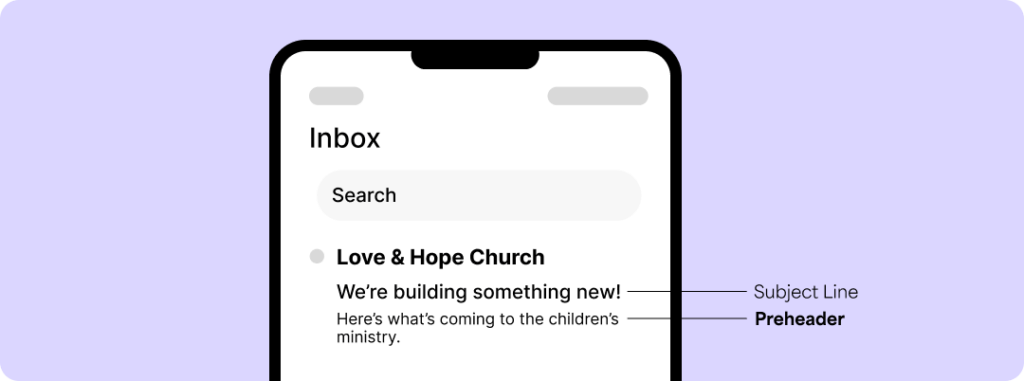5 Reasons Your Church Newsletter Emails Go Unread and How to Fix Them

Did you know over 4.6 billion people use email worldwide?
With 376 billion emails sent daily, email remains a powerful communication tool. Yet the average person gets 120 emails a day and spends just 9 seconds reading each one.
These numbers are a wake-up call for faith leaders. While church newsletters and emails are effective tools for informing and staying connected with your congregation, they only work if people open and read them.
Before you hit send, watch for common email pitfalls — and learn simple ways to help your church emails stand out.
Why church newsletters are important
Beyond sharing stories, email newsletters are powerful tools for church leaders to communicate and connect with their congregations.
When filled with valuable, relevant content, church newsletters become more than monthly messages — they become the “go-to” source church members rely on as the voice of leadership.
They also reinforce your church’s values and mission. Whether printed directly or reflected in stories, photos, or thought-leadership content, newsletters remind your congregation of who you are and what you stand for as a faith organization.
Church newsletters foster relationships, too. Highlighting anniversaries, birthdays, graduations, or new babies creates shared moments members can celebrate. Promoting events like seminars, guest speakers, fundraisers, and service projects encourages participation and boosts engagement.
Finally, newsletters are information “gap-fillers” for members who are unable to attend church services and those who may miss weekly service announcements. This is particularly useful when attendance is lower, whether it’s due to summer vacations, holiday absences, or just unexpected life events — newsletters can keep everyone in the know.
Now, let’s dive into the five email missteps that prevent your church messages from being opened and the small tweaks that can fix them.
Reason 1: You haven’t considered the audience for your church newsletter
One reason your church emails aren’t being read is that you may not fully understand the audience you’re sending to. Even the most engaging content loses impact if it doesn’t reach the right audience in the right way.
To boost engagement, you must understand who you’re writing for. Start by asking: Who is my audience? While the easy answer might be “my entire congregation,” take a closer look. Who really makes up the core of your church community?
Is your congregation city-based or rural? Do you have a lot of young families in your sanctuary on Sundays, or are they older adults? Do more people attend church in person, or do you have a larger online following?
Answering questions like this helps you shape the content you share. And when it’s the content they want, they’ll engage more.
One of the easiest ways to learn what your congregation wants? Simply ask them. Use a survey to find out what stories, updates, and spiritual content matter to them. You can also test different versions of your church newsletter to see what resonates — change which story a reader sees first or try new subject lines (more on that soon!) to improve engagement.
Reason 2: You’re using ineffective subject lines
Did you know that nearly half (47%) of email recipients open emails solely based on the subject line?
Your email subject line is the first impression readers will have of your message. And if you think of it as the opening line of the story you’d like to tell, you can create a subject line that sparks curiosity and invites the reader to keep going.
Here are a few tips for how to write impactful subject lines to get your next church newsletter noticed and opened:
- Aim for click-worthy, not clickbait: The difference between a compelling subject line and clickbait comes down to trust. Both are designed to grab attention, but clickbait often misleads — overpromising and underdelivering. A click-worthy subject line, on the other hand, entices readers while delivering real value. To earn your audience’s trust (and clicks), avoid generic subject lines and tailor them to the heart of your message.
- Keep it brief: When it comes to subject lines, shorter is stronger. Aim for no more than nine words, though four to seven is ideal, and between 30 and 50 characters long.
- Add a personal touch: Readers are 26% more likely to open emails with personalized subject lines. This can include using the recipient’s first name (“Michelle, your giving is making a difference”), referencing a past behavior (“Thanks for joining us last Sunday!”), or even recognizing an important life moment (“Wishing you a joyful birthday!”). When people feel seen, they are more likely to open your email.
- Use emojis wisely: Research shows that open rates can increase by 56% when emojis appear in subject lines. But don’t overdo it. Aim for no more than two to avoid using valuable character space.
- Personalize your sender: Research has shown that more emails are opened if they’re from a person instead of an organization. Consider using a leader’s name as the “sender” of the email, versus the church name or a particular ministry.
When writing your email subject line, keep these guidelines in mind to entice readers to open your church newsletter as well:
- Spark curiosity: Tap into your reader’s desire to “learn more” by teasing what they’ll see as they continue reading.
- Create FOMO: No one wants to be the last in the know. Address FOMO (Fear of Missing Out) by creating subject lines that make readers feel like they’re missing out if they don’t engage with your content.
- Speak to their hearts: Use subject lines as lead-ins to messages of comfort and clarity that touch on the feelings, topics, and issues that matter to your congregation.
Reason 3: You’re not leveraging your preheaders

Known as “preview text,” preheaders are short lines of text that appear after your email subject line in inboxes. They offer a second chance for your email to make a strong first impression.
The ideal preheader length varies by email client. An email client is simply the software you use to read, create, and manage emails, like Microsoft Outlook, Gmail, or Apple Mail. Ideally, preheader text should be between 40 and 130 characters. To really optimize them, aim for between 30 and 55 characters.
Here’s how to make your preheaders work for you:
- Complement your subject line: Preheaders should elaborate on the subject line without repeating it. Think of them as a (short) extension of your subject line that sparks more interest in your content.
Subject: We’re building something new!
Preheader: Here’s what’s coming to the children’s ministry.
- Personalize it: Use your church newsletter recipient’s name, their interests, or other information to make your preheader more appealing. “Patricia, here’s a sneak peek at our new playground,” will connect better than a more generic message.
- Make it actionable: Add a CTA (Call-To-Action) to give readers a reason to open your email. Examples include “Find out how to help” or “Register and join us this Friday.”
Though short, preheaders give readers a reason to care about your message. And just as a good preheader can lead to higher open rates, a poor one can result in ignored emails.
A few tips to remember for standout preheaders:
- Your subject line will determine how much of your preview text is displayed. Make sure it complements the subject line and extends the intro to the story you want readers to explore.
- Eighty-five percent of users access their inboxes on a mobile device, so be sure to structure preheaders for this significant audience share. Because mobile email clients typically show less text, stick to shorter preheaders between 30 and 80 characters.
- If the text is too short, email clients may pull text from the beginning of your email to create a preheader. On the other hand, if the text is too long, your preheader may be cut off. So be sure to lead with what’s important.
Reason 4: Your church newsletter content falls flat
Now that you know your audience and have strong subject lines and preheaders, it’s time to focus on what matters most — content.
Content is the meat and potatoes of church newsletters. It is the heart of your message. And if it doesn’t connect, inform, or inspire, readers may tune out. The good news? A mix of content keeps things fresh and meaningful.
Messages from leadership, inspiring member stories, testimonials, and service event photos all help make newsletters well-rounded and relevant for a diverse audience.
Use these insights to build stronger, more engaging content for your church newsletter:
- Lead with strong messaging: Don’t make readers scroll to find what’s most important. Though people are scrolling vertically more than they used to, content above the fold receives the highest share (57%) of viewing time.
- Keep content concise: Copy should be short, to the point, and easily scannable. This doesn’t mean you can’t tell a longer story. But keeping paragraphs and sections short makes newsletters more inviting and easier on readers’ eyes. Have a longer story to tell? Just break them up into smaller, more digestible pieces. You can even create a series to encourage readers to open the next issue.
- Aim for variety: Newsletter content doesn’t have to be the same from issue to issue. While staples like a pastor’s editorial may be standard, it’s okay to change up the rest. One month could feature a standout volunteer, and the next month, spotlight a community outreach event.
Reason 5: You don’t have a clear call-to-action

A Call-to-Action (CTA) is just what it sounds like: a clear, purposeful prompt that encourages readers to act. Whether it’s reading a blog, downloading a guide, or sharing a devotional, a strong CTA highlights the value of what’s in it for a reader when they go beyond the “click.”
CTAs are simple and short in their design. Aim for two to four words. Research shows that emails with two to three CTAs receive the highest click-through rates, while emails with more than three see lower click-through rates.
Here are some tips for crafting effective call to actions for your church newsletters:
- Show the value: Instead of saying “Click here,” outline what readers will receive when they click a link. “Get the guide,” “Watch the message,” or “Read the full story” are stronger alternatives.
- Create urgency: Phrases like “Register today” or “Limited spots available” encourage quicker action than a more generic “Sign up.”
- Make it personal: CTAs like “Count me in” or “Reserve my seat” feel more engaging than generic phrases.
Make every church newsletter and email count
Your congregations’ inboxes are more crowded than ever. And it takes more than good intentions to keep emails open and read. By carefully considering your audience, creating subject lines and preheaders that encourage engagement, crafting content that connects, and implementing strong calls to action — every message you send can matter.



